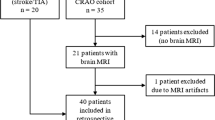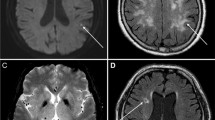Abstract
Purpose
Gadolinium leakage in ocular structures (GLOS) on fluid-attenuated inversion recovery images (FLAIR) is a novel imaging marker in acute ischemic stroke. The present study sought to investigate the frequency and pattern of blood-retina barrier impairment in acute ischemic stroke due to internal carotid artery (ICA) stenosis or occlusion as demonstrated by GLOS.
Methods
From a magnetic resonance imaging (MRI) report database patients were identified with acute ischemic stroke due to ICA stenosis/occlusion who underwent repeated MRI with intravenous contrast agent administration and FLAIR and MR angiography (MRA). On FLAIR the presence of GLOS was noted in the vitreous body.
Results
Overall 51 patients with a median age of 70 years (interquartile range, IQR 63–77 years) were included. Of these, 22 (43.1%) patients had an ICA stenosis and 29 (56.9%) an ICA occlusion. On contrast-enhanced FLAIR, GLOS was observed in 29 (56.9%) patients: in 7 (13.7%) unilateral, in 15 (68.2%) bilateral asymmetrical and in 7 (31.8%) bilateral symmetrical. In unilateral asymmetrical GLOS, more pronounced enhancement was always found ipsilateral to ICA stenosis/occlusion. In 4 (5.9%) patients with asymmetrical GLOS a pre-existing signal increase in the vitreous body was found on native FLAIR. The presence of GLOS was associated with an impaired collateralization through the circle of Willis (p < 0.001) and external carotid artery branches (p = 0.03).
Conclusion
In patients with ischemic stroke due to ICA stenosis/occlusion, GLOS is frequent, commonly unilateral or bilateral asymmetrical, and in some patients associated with pre-existing ocular signal abnormalities. An insufficient collateralization may contribute to the development of unilateral/asymmetrical GLOS.



Similar content being viewed by others
References
Mathews VP, Caldemeyer KS, Lowe MJ, Greenspan SL, Weber DM, Ulmer JL. Brain: gadolinium-enhanced fast fluid-attenuated inversion-recovery MR imaging. Radiology. 1999;211:257–63.
Splendiani A, Puglielli E, De Amicis R, Necozione S, Masciocchi C, Gallucci M. Contrast-enhanced FLAIR in the early diagnosis of infectious meningitis. Neuroradiology. 2005;47:591–8.
Alonso A, Eisele P, Ebert AD, Griebe M, Engelhardt B, Szabo K, Hennerici MG, Gass A. Leptomeningeal contrast enhancement and blood-CSF barrier dysfunction in aseptic meningitis. Neurol Neuroimmunol Neuroinflamm. 2015;2:e164.
Galassi W, Phuttharak W, Hesselink JR, Healy JF, Dietrich RB, Imbesi SG. Intracranial meningeal disease: comparison of contrast-enhanced MR imaging with fluid-attenuated inversion recovery and fat-suppressed T1-weighted sequences. AJNR Am J Neuroradiol. 2005;26:553–9.
Griffiths PD, Coley SC, Romanowski CA, Hodgson T, Wilkinson ID. Contrast-enhanced fluid-attenuated inversion recovery imaging for leptomeningeal disease in children. AJNR Am J Neuroradiol. 2003;24:719–23.
Latour LL, Kang DW, Ezzeddine MA, Chalela JA, Warach S. Early blood-brain barrier disruption in human focal brain ischemia. Ann Neurol. 2004;56:468–77.
Absinta M, Vuolo L, Rao A, Nair G, Sati P, Cortese IC, Ohayon J, Fenton K, Reyes-Mantilla MI, Maric D, Calabresi PA, Butman JA, Pardo CA, Reich DS. Gadolinium-based MRI characterization of leptomeningeal inflammation in multiple sclerosis. Neurology. 2015;85:18–28.
Mamourian AC, Hoopes PJ, Lewis LD. Visualization of intravenously administered contrast material in the CSF on fluid-attenuated inversion-recovery MR images: an in vitro and animal-model investigation. AJNR Am J Neuroradiol. 2000;21:105–11.
Bahn MM, Gordon RE, Wippold FJ, Grand MG. Findings of retinitis on gadolinium-enhanced turbo fluid-attenuated inversion recovery images. Retina. 1998;18:164–8.
Hamel J, Fiebach JB, Villringer K. Ocular hyperintense acute reperfusion marker. Neurology. 2012;79:1622–3.
Pino-Lopez L, Wenz H, Böhme J, Maros M, Schlichtenbrede F, Groden C, Förster A. Contrast-enhanced fat-suppressed FLAIR for the characterization of leptomeningeal inflammation in optic neuritis. Mult Scler. 2018; https://doi.org/10.1177/1352458518770268.
Herrera DA, Franco S, Bustamante S, Vargas SA, Ochoa-Escudero M, Dublin AB, Cuevas M. Contrast-enhanced T2-FLAIR MR imaging in patients with uveitis. Int Ophthalmol. 2017;37:507–12.
Hitomi E, Simpkins AN, Luby M, Latour LL, Leigh RJ, Leigh R. Blood-ocular barrier disruption in patients with acute stroke. Neurology. 2018;90:e915–e23.
von Reutern GM, Goertler MW, Bornstein NM, Del Sette M, Evans DH, Hetzel A, Kaps M, Perren F, Razumovky A, von Reutern M, Shiogai T, Titianova E, Traubner P, Venketasubramanian N, Wong LK, Yasaka M; Neurosonology Research Group of the World Federation of Neurology. Grading carotid stenosis using ultrasonic methods. Stroke. 2012;43:916–21.
Keller H, Meier W, Yonekawa Y, Kumpe D. Noninavasive angiography for the diagnosis of carotid artery disease using Doppler ultrasound (carotid artery Doppler). Stroke. 1976;7:354–63.
Tatu L, Moulin T, Bogousslavsky J, Duvernoy H. Arterial territories of human brain: brainstem and cerebellum. Neurology. 1996;47:1125–35.
Tatu L, Moulin T, Bogousslavsky J, Duvernoy H. Arterial territories of the human brain: cerebral hemispheres. Neurology. 1998;50:1699–708.
Rozanski M, Ebinger M, Schmidt WU, Hotter B, Pittl S, Heuschmann PU, Jungehuelsing JG, Fiebach JB. Hyperintense acute reperfusion marker on FLAIR is not associated with early haemorrhagic transformation in the elderly. Eur Radiol. 2010;20:2990–6.
Förster A, Wenz H, Böhme J, Al Zghloul M, Groden C. Hyperintense acute reperfusion marker on FLAIR in posterior circulation infarction. PLoS ONE. 2016;11:e157738.
Ozkan E, Gocmen R, Topcuoglu MA, Arsava EM. Blood-retina-barrier disruption accompanying blood-brain-barrier dysfunction in posterior reversible encephalopathy syndrome. J Neurol Sci. 2014;346:315–7.
Steuer H, Jaworski A, Elger B, Kaussmann M, Keldenich J, Schneider H, Stoll D, Schlosshauer B. Functional characterization and comparison of the outer blood-retina barrier and the blood-brain barrier. Invest Ophthalmol Vis Sci. 2005;46:1047–53.
Klijn CJ, Kappelle LJ, van Schooneveld MJ, Hoppenreijs VP, Algra A, Tulleken CA, van Gijn J. Venous stasis retinopathy in symptomatic carotid artery occlusion: prevalence, cause, and outcome. Stroke. 2002;33:695–701.
Barr TL, Latour LL, Lee KY, Schaewe TJ, Luby M, Chang GS, El Zammar Z, Alam S, Hallenbeck JM, Kidwell CS, Warach S. Blood-brain barrier disruption in humans is independently associated with increased matrix metalloproteinase-9. Stroke. 2010;41:e123–8.
Author information
Authors and Affiliations
Corresponding author
Ethics declarations
Conflict of interest
A. Förster, H. Wenz, J. Böhme, C. Groden and A. Alonso declare that they have no competing interests.
Additional information
A. Förster and H. Wenz contributed equally to this work.
Rights and permissions
About this article
Cite this article
Förster, A., Wenz, H., Böhme, J. et al. Asymmetrical Gadolinium Leakage in Ocular Structures in Stroke Due to Internal Carotid Artery Stenosis or Occlusion. Clin Neuroradiol 30, 221–228 (2020). https://doi.org/10.1007/s00062-018-0754-5
Received:
Accepted:
Published:
Issue Date:
DOI: https://doi.org/10.1007/s00062-018-0754-5




